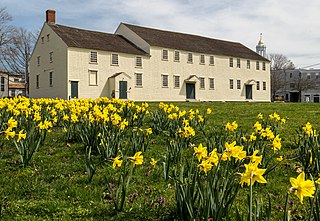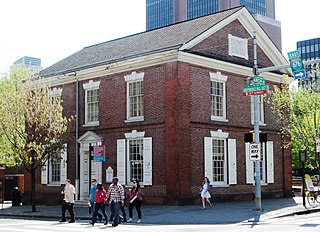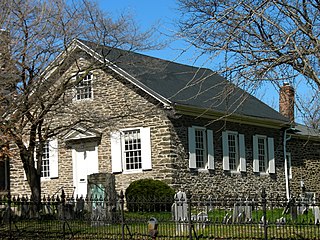
Plymouth Meeting is a census-designated place (CDP) that straddles Plymouth and Whitemarsh Townships in Montgomery County, Pennsylvania, United States. The settlement was founded in 1686.

The Richard Wall house, built 1682, is a historic home in Elkins Park, Pennsylvania. It had continuous Wall family residency for over 150 years, having been in the Wall family and its descendants through 1847. It is listed in the National Register of Historic Places as "Wall House" also known as "The Ivy".

A Friends meeting house is a meeting house of the Religious Society of Friends (Quakers), where meeting for worship is usually held.

The Arch Street Meeting House, at 320 Arch Street at the corner of 4th Street in the Old City neighborhood of Philadelphia, Pennsylvania, is a Meeting House of the Religious Society of Friends (Quakers). Built to reflect Friends' testimonies of simplicity and equality, this building is little changed after more than two centuries of continuous use.

The Buckingham Friends Meeting House is a historic Quaker meeting house at 5684 Lower York Road in Buckingham Township, Bucks County, Pennsylvania. Built in 1768 in a "doubled" style, it is nationally significant as a model for many subsequent Friends Meeting Houses. It was declared a National Historic Landmark in 2003.

The Merion Friends Meeting House is an active and historic Quaker meeting house at 615 Montgomery Avenue in Merion Station, Pennsylvania. Completed about 1715, it is the second oldest Friends meeting house in the United States, with distinctively Welsh architectural features that distinguish it from later meeting houses. It is home to the Merion monthly meeting. The meeting house was declared a National Historic Landmark in 1999.

The Nine Partners Meeting House and Cemetery is located at the junction of NY state highway 343 and Church Street, in the village of Millbrook, New York, United States. The meeting house, the third one on the site, was built by a group of Friends ("Quakers") from the Cape Cod region, Nantucket and Rhode Island in 1780.

Caln Meeting House is a historic Quaker meeting house located at 901 Caln Meeting House Road, near Coatesville in Caln Township, Chester County, Pennsylvania. It was built in 1726, and is a one-story, tan fieldstone structure. It was enlarged to its present size in 1801.

Birmingham Friends Meetinghouse is a historic Quaker meeting house at 1245 Birmingham Road in Birmingham Township, Chester County, Pennsylvania. The current meetinghouse was built in 1763. The building and the adjacent cemetery were near the center of fighting on the afternoon of September 11, 1777 at the Battle of Brandywine. Worship services are held weekly at 10am. The meetinghouse and adjacent octagonal schoolhouse were listed on the National Register of Historic Places as Birmingham Friends Meetinghouse and School on July 27, 1971.

Bradford Friends Meetinghouse, also known as Marshallton Meeting House, is a historic Quaker meeting house located at Marshallton in West Bradford Township, Chester County, Pennsylvania. It was built in 1764–1765, and is a one-story, stone structure with a gable roof. A porch was added to two sides of the building in the 19th century. The interior is divided into four rooms, rather than the customary two. Abraham Marshall, father of botanist Humphry Marshall was instrumental in the establishment of the meeting in the 1720s. The meeting originally met from 1722 to 1727 at the Marshall home, Derbydown Homestead, from 1722 to 1727.

Catawissa Friends Meetinghouse is a historic Quaker meetinghouse at South and 3rd Streets in Catawissa, Columbia County, Pennsylvania. It was built about 1789, and is a one-story log building on a stone foundation. It measures 30 feet by 27 feet, 6 inches.

The Radnor Friends Meetinghouse is an historic, American Quaker meeting house that is located on Sproul and Conestoga Roads in Radnor Township, Delaware County, Pennsylvania.

The Free Quaker Meetinghouse is a historic Free Quaker meeting house at the southeast corner of 5th and Arch Streets in the Independence National Historical Park in Philadelphia, Pennsylvania. It was built in 1783, and is a plain 2 1⁄2-story brick building with a gable roof. The second floor was added in 1788. The building was moved about 30 feet (9.1 m) to its present site in 1961, to allow for the widening of Fifth Street.

The Mennonite Meetinghouse is an historic, American Mennonite church building that is located at 6119 Germantown Avenue in Philadelphia, Pennsylvania.

Mill Creek Friends Meetinghouse is a historic Quaker meeting house located near Newark, New Castle County, Delaware.

The Greenwich Historic District is a 350-acre (140 ha) historic district located in the Greenwich section of Greenwich Township in Cumberland County, New Jersey, United States. It extends from the Cohansey River north toward the neighboring settlement of Othello. The district was added to the National Register of Historic Places on January 20, 1972, for its significance in agriculture, architecture, commerce, and politics. It includes 19 contributing buildings, many documented by the Historic American Buildings Survey (HABS).

The Hovenden House, Barn and Abolition Hall is a group of historic buildings which are located in Plymouth Meeting, Whitemarsh Township, Montgomery County, Pennsylvania. In the decades prior to the American Civil War, this property served as an important station on the Underground Railroad. Abolition Hall was built to be a meeting place for abolitionists, and later was the studio of artist Thomas Hovenden.

Plymouth Meeting Historic District is a national historic district that straddles Plymouth and Whitemarsh Townships in Montgomery County, Pennsylvania, United States. The adjacent Cold Point Historic District is north of it.
Butler Pike is a road in Montgomery County, Pennsylvania, that runs northeast from Conshohocken to Horsham Township. For most of its 9.8-mile (15.8 km) length, it is a county road and forms a boundary between townships.


























